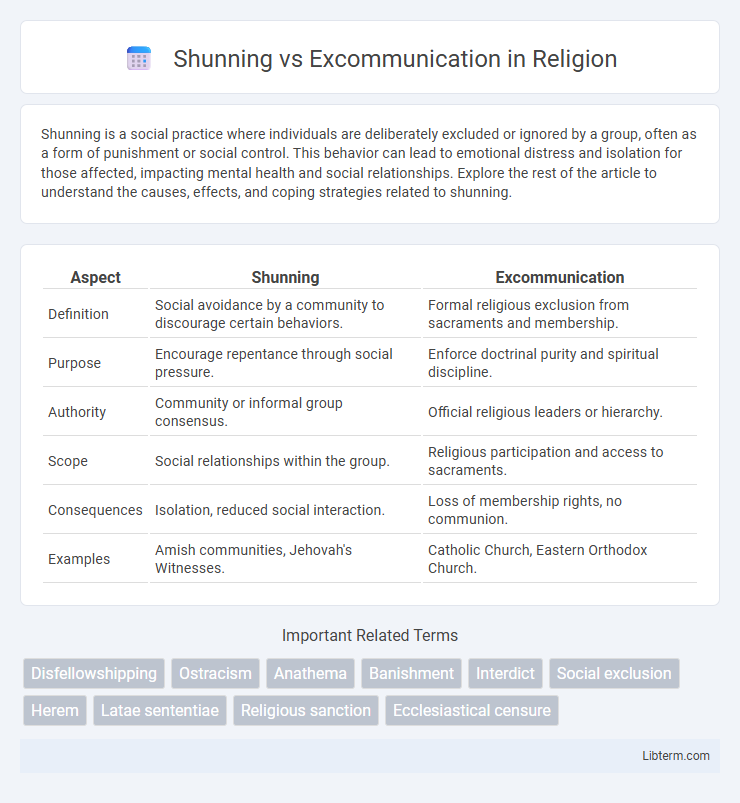Shunning is a social practice where individuals are deliberately excluded or ignored by a group, often as a form of punishment or social control. This behavior can lead to emotional distress and isolation for those affected, impacting mental health and social relationships. Explore the rest of the article to understand the causes, effects, and coping strategies related to shunning.
Table of Comparison
| Aspect | Shunning | Excommunication |
|---|---|---|
| Definition | Social avoidance by a community to discourage certain behaviors. | Formal religious exclusion from sacraments and membership. |
| Purpose | Encourage repentance through social pressure. | Enforce doctrinal purity and spiritual discipline. |
| Authority | Community or informal group consensus. | Official religious leaders or hierarchy. |
| Scope | Social relationships within the group. | Religious participation and access to sacraments. |
| Consequences | Isolation, reduced social interaction. | Loss of membership rights, no communion. |
| Examples | Amish communities, Jehovah's Witnesses. | Catholic Church, Eastern Orthodox Church. |
Understanding Shunning and Excommunication
Shunning involves members deliberately avoiding social or personal interaction with an individual to enforce community norms without formal expulsion, often used in religious or social groups. Excommunication is a formal act by a religious authority that officially excludes a member from participation in sacraments and community life, signaling a severe disciplinary measure. Both practices serve to maintain group integrity but vary in social and institutional consequences.
Historical Origins of Shunning and Excommunication
Shunning originated in early Anabaptist and Amish communities as a social and religious mechanism to enforce discipline and maintain group purity by isolating members who violated communal norms. Excommunication has roots in medieval Christianity, particularly within the Catholic Church, where it served as a formal ecclesiastical censure to exclude individuals from the sacraments and community participation for serious doctrinal or ethical transgressions. Both practices reflect historical efforts to preserve religious authority and social order through varying degrees of exclusion.
Key Differences Between Shunning and Excommunication
Shunning involves social avoidance by members of a community without formal declaration, aimed at encouraging repentance through isolation, while excommunication is an official church or organizational act that formally removes an individual's membership and spiritual privileges. Shunning primarily targets personal relationships and daily interactions, whereas excommunication impacts legal standing within the religious institution and access to sacraments or rites. Key differences also include the reversibility, with shunning often lifted upon reconciliation, while excommunication requires formal reinstatement procedures.
Religious Contexts: Shunning vs Excommunication
Shunning and excommunication are disciplinary practices used in religious contexts to enforce community standards and doctrinal conformity. Shunning involves social avoidance and exclusion from informal fellowship to encourage repentance, commonly seen in Jehovah's Witnesses and Amish communities. Excommunication is a formal ecclesiastical censure that removes a member's rights and privileges within the church, typical in Catholic, Orthodox, and some Protestant traditions.
Social Impacts on Individuals and Communities
Shunning isolates individuals by cutting off all social and familial interactions, often leading to severe emotional distress and decreased mental well-being. Excommunication formally removes members from religious communities, impacting their spiritual identity and social support networks. Both practices significantly alter community dynamics by reinforcing conformity and controlling dissent, but shunning intensifies social exclusion through continuous personal avoidance.
Psychological Effects of Shunning vs Excommunication
Shunning isolates individuals from their community, leading to feelings of intense loneliness, anxiety, and diminished self-worth due to social rejection and loss of support networks. Excommunication, while also involving social exclusion, often carries formal religious or organizational condemnation, intensifying guilt, shame, and identity crises. Both practices can result in severe psychological distress, but shunning's pervasive social isolation typically causes more profound and enduring emotional trauma.
Legal and Ethical Considerations
Shunning involves social ostracism without legal consequences, often rooted in religious or cultural norms, whereas excommunication is a formal expulsion from a religious community that may carry legal implications if tied to contractual or organizational membership. Legal considerations surrounding excommunication focus on freedom of religion and potential discrimination, while ethical concerns address individual autonomy, mental health impact, and the balance between community cohesion and personal rights. Both practices raise questions about due process, consent, and the protection of fundamental rights under constitutional and human rights law.
Case Studies and Real-Life Examples
Case studies reveal distinct differences between shunning and excommunication in religious communities, such as the Amish practice of shunning known as Meidung, which socially isolates former members to enforce conformity. In contrast, excommunication in the Catholic Church, like the case of Martin Luther, formally expels individuals from the religious community but may allow eventual reconciliation. Real-life examples highlight how shunning often results in profound social and familial severance, whereas excommunication primarily affects spiritual status and community participation.
Contemporary Perspectives and Practices
Shunning and excommunication remain significant disciplinary practices across various religious communities, often serving distinct roles in maintaining doctrinal purity and social cohesion. Contemporary perspectives emphasize the psychological and social impact on individuals, highlighting debates around human rights and community belonging. Practices vary widely, with some groups employing shunning as a non-verbal social exclusion, while others implement formal excommunication rituals with clear theological implications.
Reconciliation and Restoration Paths
Shunning entails social avoidance by the community without formal removal from membership, often encouraging personal reflection and voluntary return through repentance. Excommunication involves official expulsion from a religious group, typically requiring specific steps for reconciliation like confession, penance, and community approval before restoration. Both practices emphasize restoration but differ in procedural formality and communal involvement during the reintegration process.
Shunning Infographic

 libterm.com
libterm.com